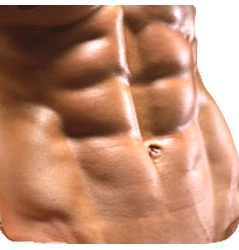Most adult males are in search of that ever elusive six pack, right? Well, most intelligent trainers and strength coaches are well aware that there is so much more than just crunches to making the core functional.

With that said, I believe abs may be one of the most over trained sets of muscles today. Some people are doing ab work daily. Why? Our abs function daily to stabilize and resist force, as well as activate trunk movements.
In reality, the aesthetics of the midsection have far more to do with nutrition and body fat than the number of crunches one does. My aim today is not to discuss this, but instead to talk about an interesting article in the latest Strength and Conditioning Journal that discusses the effects of over training the rectus abdominis on weightlifting performance.
In this article, Ellyn Robinson discusses the best way to allow athletes to stabilize weight overhead during complex lifts such as snatches, cleans and jerks. She aptly points out that if an athlete cannot stabilize the weight overhead, he/she could miss the lift in front or behind the body.
In a nutshell, she states that athletes with overdeveloped rectus abdominis tend to lose the weight out front because of a forward trunk lean. In addition, she notes that the rectus will naturally overpower the transverse abdominis and spinal erectors.
When training the core, you must consider the following muscles groups:
- Lower trunk flexors – rectus abdomimis, obliques, and psoas
- Lower trunk extensors – iliocostalis, longissimus, spinalis, multifidus, rotators and interspinalis
- Trunk stabilizers – quadratus lumborum, erector spinae, external obliques and psoas
So, beyond missing a lift overdeveloped rectus abdominis can also contribute to increased low back pain as the body comes out of its natural lordosis. Balance in the core program is key.
I have long argued that clients need to do more low back strength work to balance ab work, and she echoes that in her article. Too much abdominal work without balancing extensor work can create a posterior pelvic tilt and contribute to undue strain on the discs.
When seeking better stabilization, we should look for exercises that create compression and use isometrics. She includes exercises like:
- Seated med ball twists
- Supine bridges
- Supine bridges with alternate leg marches
- DB farmer’s walk
- Hyperextensions
** See the article for a complete list of her exercises.
The take home message here is that we as strength and conditioning professionals and rehab specialists must create a balanced core training program and be sure to emphasize the extensors and stabilizers as well as the flexors.
Reference – 2010 Strength & Conditioning Journal (Volume 23, Number 5)

